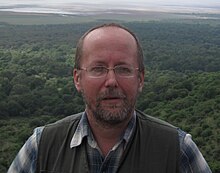
Back Andrei Korotajef Afrikaans أندريه كاراطائف Arabic اندريه كاراطائف ARZ Andréi Korotáyev AST Andrey Korotayev Azerbaijani آندری کاراطایف AZB Андрэй Вітальевіч Каратаеў Byelorussian Андрей Коротаев Bulgarian Andrei Korotàiev Catalan Andrej Korotajev Czech
A major contributor to this article appears to have a close connection with its subject. (March 2020) |
Andrey Korotayev | |
|---|---|
 Korotayev over the Rift Valley, North Tanzania, November 2008 | |
| Born | 17 February 1961 Moscow, Soviet Union |
| Nationality | Russian |
| Alma mater | Moscow State University |
| Known for | contributions to mathematical modelling of the World System development and cross-cultural studies |
| Awards | Russian Science Support Foundation Award in "The Best Economists of the Russian Academy of Sciences" nomination (2006)[1] In 2012 he was awarded with the Gold Kondratieff Medal[2] by the International N. D. Kondratieff Foundation. |
| Scientific career | |
| Fields | cross-cultural studies, mathematical modelling of social, economic, and historical dynamics; Islamic and pre-Islamic history |
| Institutions | HSE University (Moscow) Russian Academy of Sciences (Moscow) Institute for Advanced Study(Princeton) Russian State University for the Humanities (Moscow) |
Andrey Vitalievich Korotayev (Russian: Андре́й Вита́льевич Корота́ев; born 17 February 1961) is a Russian anthropologist, economic historian, comparative political scientist, demographer and sociologist, with major contributions to world-systems theory, cross-cultural studies, Near Eastern history, Big History, and mathematical modelling of social and economic macrodynamics.[3]
He is currently the Director of the Centre for Stability and Risk Analysis at the HSE University in Moscow,[4] and a Senior Research Professor at the Center for Big History and System Forecasting of the Institute of Oriental Studies[5][6] as well as in the Institute for African Studies of the Russian Academy of Sciences.[7]
In addition, he is a senior research professor of the International Laboratory on Political Demography and Social Macrodynamics (PDSM) of the Russian Presidential Academy of National Economy and Public Administration,[8] as well as a full professor of the Faculty of Global Studies of the Moscow State University.[9]
He is co-editor of the journals Social Evolution & History and Journal of Globalization Studies,[10] as well as History & Mathematics[11] yearbook[12]
Together with Askar Akayev and George Malinetsky he was in 2008-2018 a coordinator of the Russian Academy of Sciences Program "System Analysis and Mathematical Modeling of World Dynamics".[13]
- ^ "The Best Economists of the Russian Academy of Sciences". Russian Academy of Sciences. Archived from the original on 24 December 2018. Retrieved 27 June 2006.
- ^ "ИТОГИ VII МЕЖДУНАРОДНОГО КОНКУРСА НА СОИСКАНИЕ ЗОЛОТОЙ, СЕРЕБРЯНОЙ, БРОНЗОВОЙ МЕДАЛЕЙ И ПАМЯТНОЙ МЕДАЛИ ДЛЯ МОЛОДЫХ УЧЕНЫХ «За вклад в развитие общественных наук» от 28 апреля 2012 года". ИТОГИ VII МЕЖДУНАРОДНОГО КОНКУРСА НА СОИСКАНИЕ ЗОЛОТОЙ, СЕРЕБРЯНОЙ, БРОНЗОВОЙ МЕДАЛЕЙ И ПАМЯТНОЙ МЕДАЛИ ДЛЯ МОЛОДЫХ УЧЕНЫХ «За вклад в развитие общественных наук» от 28 апреля 2012 года. 30 September 2019. Archived from the original on 12 October 2013.
- ^ Global Studies Directory. ISBN 9789004348479. Leiden: Brill, 2018, pp. 182–183.
- ^ "HSE University - Moscow staff". hse.ru.
- ^ Институт Востоковедения Российской Академии Наук
- ^ Институт Востоковедения Российской Академии Наук
- ^ "Centre for Civilisational and Regional Studies | Institute for African Studies". inafran.ru.
- ^ RANEPA - First International Conference on Political Demography and Social Macro-Dynamics
- ^ "Андрей Витальевич Коротаев". Istina. Retrieved 31 December 2013.
- ^ "Journal of Globalization Studies". 2010. ISSN 2075-8103.
- ^ "History and mathematics: Historical Dynamics and Development of Complex Societies". URSS. Archived from the original on 22 July 2010. Retrieved 31 December 2013.
- ^ Almanac (together with Leonid Grinin and Arno Tausch).
- ^ Note that the analysis of log-linear oscillations in the gold price dynamics for 2003–2010 conducted by him together with Askar Akayev allowed them to forecast in November 2010 a possible start of the second wave of the global crisis in June – August 2011. See Askar Akayev, Alexey Fomin, Sergey Tsirel, and Andrey Korotayev. Log-Periodic Oscillation Analysis Forecasts the Burst of the "Gold Bubble" in April – June 2011. Structure and Dynamics 4/3 (2010): 1–11.